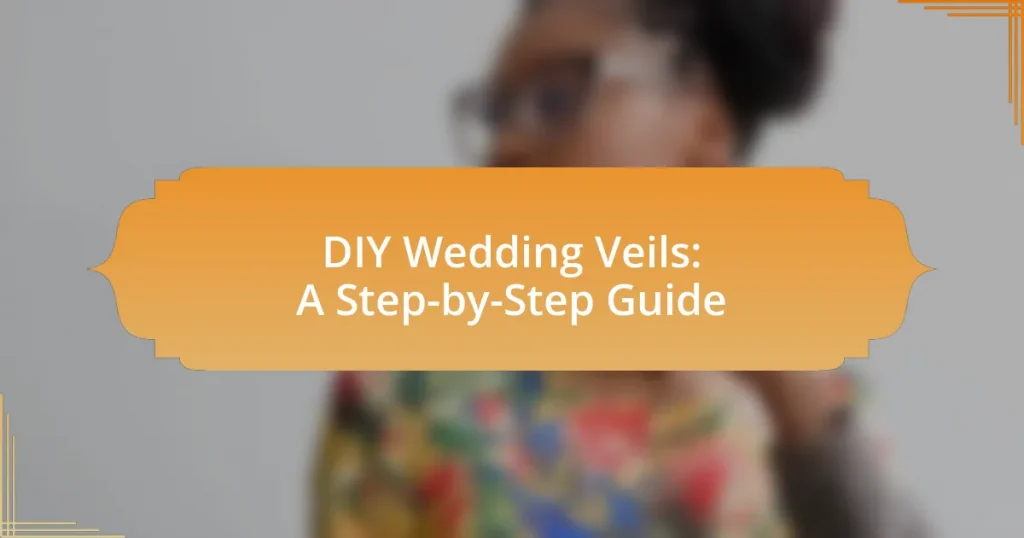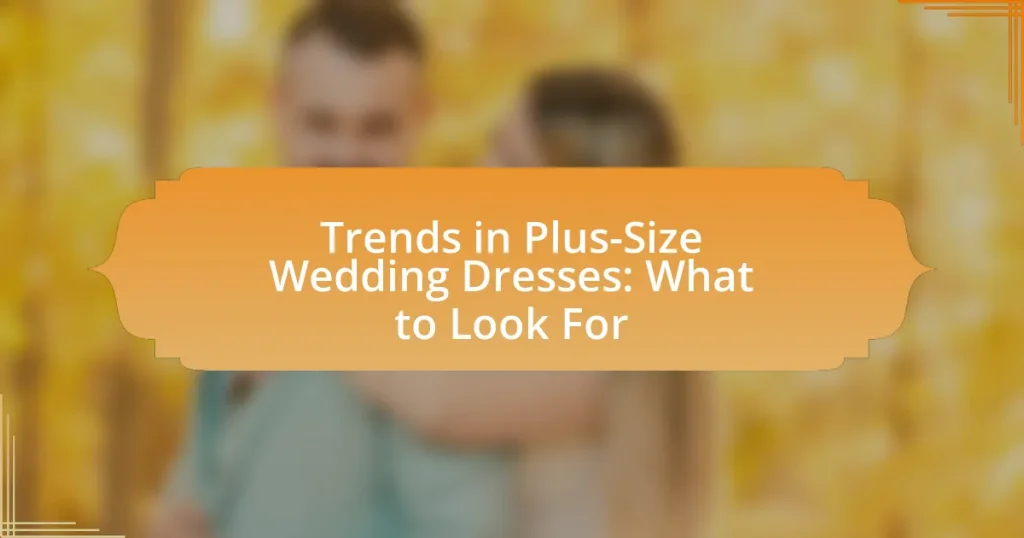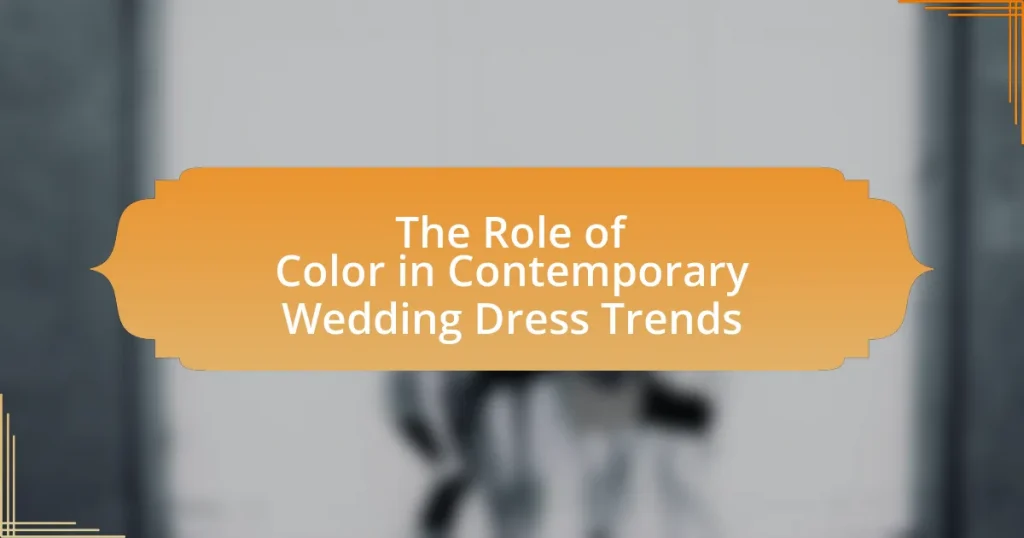DIY wedding veils are custom-made veils created by brides to reflect their personal style and wedding theme. This article provides a comprehensive guide on the benefits of making your own veil, including cost savings and the opportunity for personalization through various materials such as tulle, lace, and organza. It outlines popular styles, the step-by-step process for crafting a veil, and tips for sourcing materials and troubleshooting common issues. Additionally, the article discusses how to enhance the veil with embellishments and offers best practices for maintenance and storage, ensuring that the DIY veil remains a beautiful accessory for the wedding day.
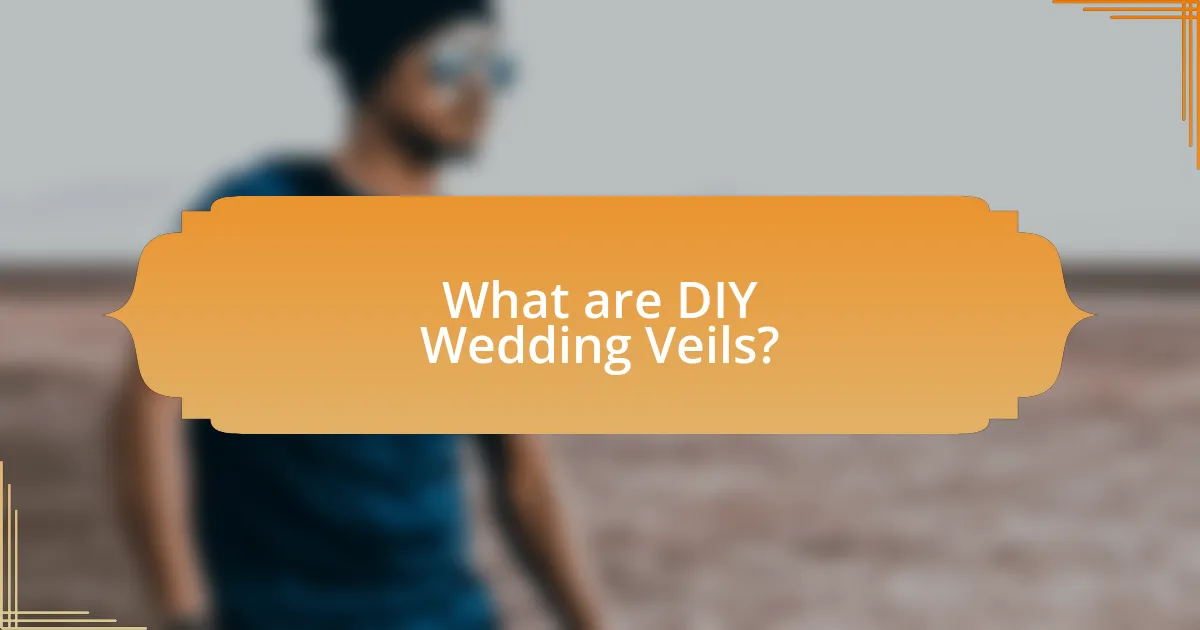
What are DIY Wedding Veils?
DIY wedding veils are handmade veils created by individuals for their own weddings, allowing for customization in style, length, and materials. These veils can be crafted using various fabrics such as tulle, lace, or organza, and can incorporate personal touches like embellishments or unique designs. The DIY approach not only provides a cost-effective alternative to store-bought options but also allows brides to express their individuality and creativity on their special day.
How can DIY wedding veils enhance your wedding experience?
DIY wedding veils can enhance your wedding experience by allowing for personalization and creativity, making the veil a unique reflection of your style. Creating a veil yourself enables you to choose materials, colors, and designs that resonate with your vision for the wedding, ensuring it complements your dress and overall theme. Additionally, the process of making the veil can be a meaningful activity, fostering a sense of accomplishment and connection to the wedding preparations. Engaging in DIY projects often leads to memorable experiences with friends or family who may assist, further enriching the emotional significance of the wedding day.
What materials are commonly used in DIY wedding veils?
Common materials used in DIY wedding veils include tulle, lace, organza, and chiffon. Tulle is a lightweight, net-like fabric that provides a classic veil look, while lace adds elegance and intricate detailing. Organza, known for its crispness and sheen, offers a structured appearance, and chiffon, with its soft drape, creates a romantic feel. These materials are popular due to their availability and versatility, allowing for various styles and lengths in veil design.
How do different materials affect the overall look of the veil?
Different materials significantly influence the overall look of a veil by altering its texture, drape, and visual appeal. For instance, silk creates a luxurious and smooth appearance, often reflecting light beautifully, while tulle offers a more ethereal and soft look due to its lightweight and airy nature. Lace adds intricate detailing and a vintage charm, enhancing the veil’s elegance. Additionally, organza provides a crisp and structured silhouette, making the veil appear more formal. Each material’s unique characteristics contribute to the veil’s style, ensuring that the choice of fabric plays a crucial role in achieving the desired aesthetic for a wedding.
Why choose to make your own wedding veil?
Making your own wedding veil allows for complete customization, ensuring that the veil perfectly matches your personal style and wedding theme. This process enables you to select the fabric, length, and embellishments that resonate with your vision, creating a unique accessory that reflects your individuality. Additionally, crafting your own veil can be more cost-effective than purchasing a pre-made one, as it often involves lower material costs and eliminates markup from retailers. According to a survey by The Knot, DIY projects can save couples an average of 20-30% on wedding expenses, making it a financially savvy choice.
What are the cost benefits of DIY wedding veils?
DIY wedding veils offer significant cost benefits, primarily by reducing expenses associated with purchasing ready-made veils. Creating a veil at home can save brides between $50 to $300, depending on the materials used and the complexity of the design. Additionally, DIY projects allow for customization, enabling brides to select fabrics and embellishments that fit their budget and personal style, further enhancing cost efficiency. By sourcing materials from local craft stores or online retailers, brides can often find high-quality options at lower prices than those found in bridal boutiques.
How can personalizing a veil reflect your wedding theme?
Personalizing a veil can reflect your wedding theme by incorporating specific colors, fabrics, or embellishments that align with the overall aesthetic of the event. For instance, if your wedding theme is vintage, using lace or antique-inspired details on the veil can enhance that atmosphere. Additionally, adding personalized elements such as embroidery of initials or meaningful symbols can create a cohesive look that ties the veil to the wedding’s narrative. This approach not only showcases individual style but also reinforces the thematic elements present in other aspects of the wedding, such as floral arrangements and decor.
What styles of DIY wedding veils are popular?
Popular styles of DIY wedding veils include cathedral, fingertip, and birdcage veils. Cathedral veils are known for their dramatic length, often extending beyond the train of the wedding dress, making them a favorite for formal ceremonies. Fingertip veils, which reach the bride’s fingertips, offer a balance of elegance and practicality, suitable for various wedding styles. Birdcage veils, characterized by their short, netted design, provide a vintage look and are often adorned with embellishments like flowers or feathers. These styles reflect current trends in bridal fashion, emphasizing personalization and creativity in DIY projects.
What are the differences between a cathedral veil and a birdcage veil?
A cathedral veil is a long, flowing veil that typically extends beyond the train of the wedding gown, while a birdcage veil is a short, netted veil that covers only part of the face, often attached to a headpiece. Cathedral veils are usually made from lightweight fabrics like tulle or lace and can be several feet long, creating a dramatic effect during the ceremony. In contrast, birdcage veils are often made from materials like tulle or netting and are designed to be more vintage or retro in style, providing a playful and chic look. The length and style differences between these two types of veils cater to different bridal aesthetics and preferences.
How can you choose the right style for your dress?
To choose the right style for your dress, assess your body shape, personal style, and the wedding theme. Understanding your body shape helps in selecting a silhouette that flatters your figure, such as A-line for pear shapes or fitted styles for hourglass figures. Personal style influences the choice between classic, modern, or bohemian designs, ensuring the dress reflects your individuality. Additionally, aligning the dress style with the wedding theme—be it formal, casual, or destination—ensures cohesion in your overall look. This approach is supported by fashion experts who emphasize the importance of these factors in achieving a harmonious bridal appearance.
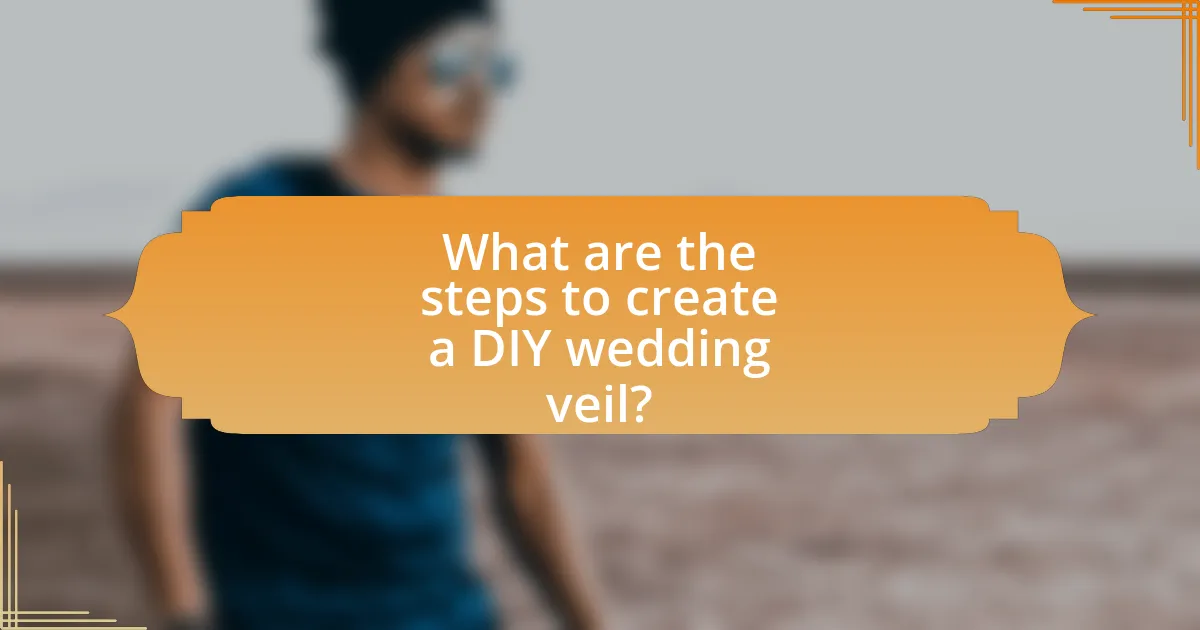
What are the steps to create a DIY wedding veil?
To create a DIY wedding veil, follow these steps: First, gather materials including tulle, a comb or headband, scissors, and a sewing kit. Next, measure the desired length of the veil and cut the tulle accordingly, allowing extra for gathering. Then, fold the tulle in half and sew along the top edge to create a channel for the comb or headband. After that, insert the comb or headband into the channel and secure it with stitches. Finally, trim the edges of the veil if necessary and ensure it is evenly shaped. These steps provide a straightforward method for crafting a personalized wedding veil.
How do you gather the necessary materials for making a veil?
To gather the necessary materials for making a veil, first identify the specific type of veil desired, as this will dictate the materials needed. Common materials include tulle or lace fabric, a comb or headband for attachment, and embellishments like beads or sequins. Additionally, tools such as scissors, a sewing machine or needle and thread, and fabric glue may be required. Researching local fabric stores or online retailers can provide options for purchasing these materials, ensuring they match the desired style and color.
What tools will you need for the DIY process?
For the DIY process of creating wedding veils, you will need scissors, a sewing machine, fabric, thread, a measuring tape, pins, and a veil comb. Scissors are essential for cutting the fabric to the desired length and shape. A sewing machine allows for efficient stitching of the veil, while fabric and thread are necessary to construct the veil itself. A measuring tape ensures accurate measurements for a perfect fit, and pins help hold the fabric in place during assembly. Finally, a veil comb is used to secure the veil in the hair. These tools are standard in DIY projects and are widely recognized for their effectiveness in crafting.
Where can you source materials for your veil?
You can source materials for your veil from fabric stores, online retailers, and craft supply shops. Fabric stores often carry a variety of tulle, lace, and satin specifically for veil-making. Online retailers like Etsy and Amazon provide a wide selection of materials, including specialty fabrics and embellishments. Craft supply shops also offer tools and accessories needed for veil construction, such as combs and ribbons. These sources ensure access to quality materials suitable for creating a personalized veil.
What is the step-by-step process for making a wedding veil?
To make a wedding veil, follow these steps: First, gather materials including tulle, a comb or headband, scissors, and a sewing kit. Second, measure the desired length of the veil and cut the tulle accordingly, allowing extra for gathering. Third, fold the tulle in half and sew a straight stitch along the top edge to create a gathering stitch. Fourth, pull the thread to gather the fabric to the desired fullness. Fifth, attach the gathered tulle to the comb or headband by sewing it securely. Finally, trim any excess tulle and ensure the veil is evenly shaped. This process is commonly used in DIY projects for creating personalized wedding veils.
How do you measure and cut the fabric for your veil?
To measure and cut the fabric for your veil, first determine the desired length and width of the veil, typically ranging from 36 to 108 inches in length and 54 inches in width. Use a measuring tape to measure from the top of your head to the desired length, adding extra inches for a finished edge. Next, lay the fabric flat on a clean surface, ensuring it is wrinkle-free. Mark the measurements with fabric chalk or a marker, then cut the fabric straight along the marked lines. This method ensures accuracy and a clean edge for your veil.
What techniques can you use to attach the veil to a headpiece?
To attach a veil to a headpiece, you can use techniques such as sewing, using hairpins, or employing a comb. Sewing the veil directly onto the headpiece provides a secure and permanent attachment, while hairpins allow for flexibility and easy adjustments. A comb can also be sewn or glued to the veil, enabling it to slide into the hair for stability. These methods are commonly used in bridal fashion, ensuring that the veil remains in place throughout the event.
What finishing touches can enhance your DIY wedding veil?
To enhance your DIY wedding veil, consider adding embellishments such as lace trim, beading, or floral appliqués. These finishing touches not only elevate the overall aesthetic but also personalize the veil to match your wedding theme. For example, lace trim can create a vintage look, while beading adds sparkle and elegance. According to bridal fashion experts, incorporating these elements can significantly increase the visual impact of the veil, making it a standout accessory on your special day.
How can embellishments like lace or beads be added?
Embellishments like lace or beads can be added to wedding veils by sewing or gluing them onto the fabric. To sew lace, align it with the edge of the veil and use a needle and thread to secure it in place, ensuring even spacing for a uniform look. For beads, thread them onto a needle and stitch them onto the veil, or use fabric glue to adhere them directly to the fabric. This method is commonly used in DIY projects, allowing for customization and personal expression in the design.
What are some creative ways to personalize your veil?
Some creative ways to personalize your veil include adding embroidery, incorporating lace from a family heirloom, or attaching meaningful charms. Embroidery can feature initials, wedding dates, or special symbols, enhancing the veil’s uniqueness. Using lace from a family heirloom not only adds a personal touch but also connects generations, making the veil more sentimental. Attaching charms, such as a small locket or a piece that represents a loved one, can further customize the veil and serve as a cherished keepsake. These methods allow for a distinctive and meaningful accessory that reflects personal style and heritage.
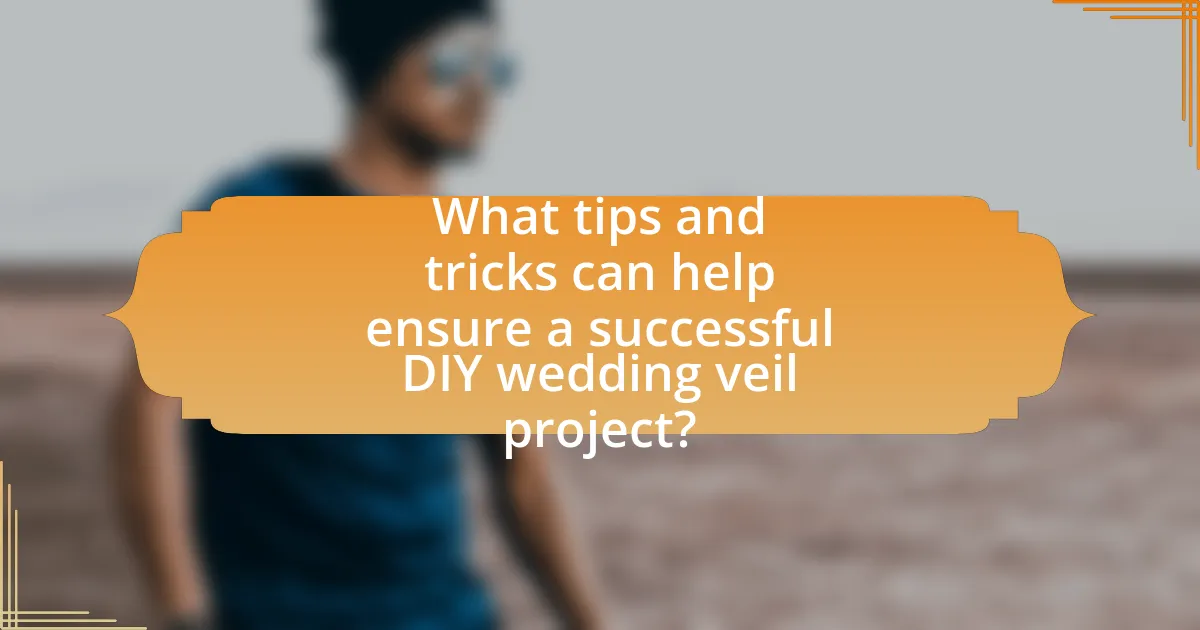
What tips and tricks can help ensure a successful DIY wedding veil project?
To ensure a successful DIY wedding veil project, start by selecting high-quality materials such as tulle or lace, which provide a beautiful and elegant appearance. Proper planning is essential; measure the desired length and width of the veil accurately to avoid mistakes during cutting. Use a sewing machine for clean edges and consider adding embellishments like beads or sequins to enhance the design. Additionally, practice basic sewing techniques on scrap fabric before working on the actual veil to build confidence and skill. Following these tips can lead to a polished and professional-looking veil that complements the wedding attire.
How can you troubleshoot common issues when making a veil?
To troubleshoot common issues when making a veil, first identify the specific problem, such as uneven edges, fabric fraying, or incorrect length. For uneven edges, ensure that you are cutting the fabric with a straight edge and using a rotary cutter for precision. If fabric fraying occurs, apply a fray check solution to the edges or use a zigzag stitch to secure them. For incorrect length, measure carefully before cutting and use a measuring tape to ensure accuracy. These methods are effective as they address the root causes of common veil-making issues, ensuring a polished final product.
What should you do if the fabric frays during cutting?
If the fabric frays during cutting, you should apply a fray check solution to the edges immediately. This solution helps to seal the fibers and prevent further fraying, ensuring a clean edge for your project. Fray check products contain a liquid that penetrates the fabric and hardens, providing a protective barrier. Using this method is effective for various types of fabrics, especially those prone to fraying, such as chiffon or organza, which are commonly used in DIY wedding veils.
How can you fix mistakes in the sewing process?
To fix mistakes in the sewing process, identify the error and determine the best method for correction. Common mistakes include uneven seams, misaligned fabric, or incorrect stitching. For uneven seams, unpick the stitches using a seam ripper and resew the seam with a consistent seam allowance. If fabric is misaligned, carefully unpin and reposition the fabric before re-sewing. For incorrect stitching, remove the faulty stitches and re-stitch according to the pattern instructions. These methods are effective as they allow for precise adjustments, ensuring the final product meets the desired quality standards.
What are some best practices for maintaining your DIY wedding veil?
To maintain your DIY wedding veil, store it properly by hanging it in a cool, dry place away from direct sunlight to prevent discoloration and damage. Additionally, gently clean the veil using a soft, lint-free cloth or a specialized fabric cleaner, ensuring to test any cleaning solution on a small, inconspicuous area first. Avoid using harsh chemicals or machine washing, as these can compromise the fabric’s integrity. Regularly inspect the veil for any signs of wear or damage, and repair any issues promptly to preserve its condition. These practices help ensure the longevity and beauty of your DIY wedding veil.
How should you store your veil before the wedding day?
To store your veil before the wedding day, place it in a clean, dry, and breathable garment bag to prevent dust and damage. This method protects the delicate fabric from creasing and environmental factors. Additionally, avoid folding the veil; instead, lay it flat or hang it to maintain its shape. Using acid-free tissue paper can also help to prevent creases if the veil must be folded. Proper storage ensures that the veil remains pristine and ready for the wedding.
What cleaning methods are safe for different veil materials?
Safe cleaning methods for different veil materials vary based on the fabric type. For tulle, hand washing in cold water with mild detergent is recommended, as it prevents damage and maintains its shape. Silk veils should be dry cleaned to avoid water stains and preserve the delicate fibers. For lace, spot cleaning with a gentle fabric cleaner is effective, ensuring that the intricate designs are not compromised. Organza can be hand washed or dry cleaned, but it is crucial to avoid wringing to prevent creasing. These methods are validated by fabric care guidelines that emphasize the importance of using appropriate techniques to maintain the integrity of each material.
